Silk plaster: reviews. How much does silk plaster cost
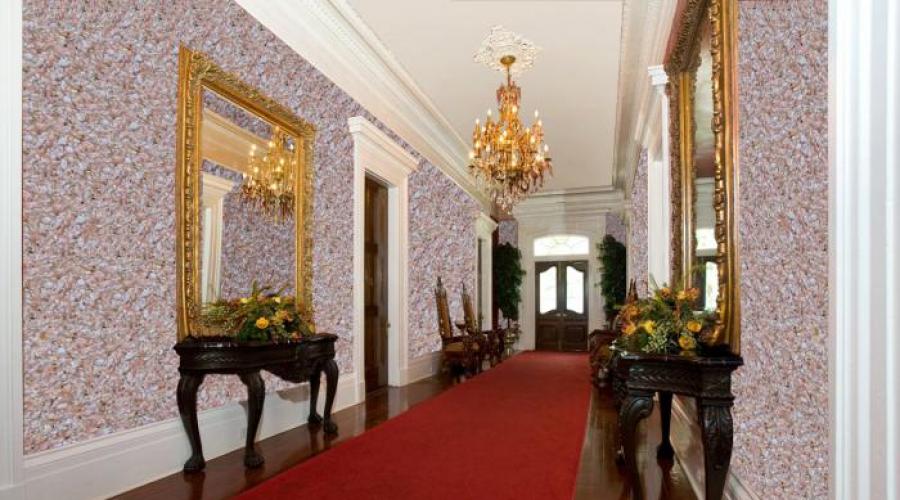
Decorative dry mixes allow you to imitate almost any materials that have nothing to do with them. A prime example is silk plaster. Reviews of experts speak of its great prospects in the future. From the name it becomes clear to imitate what kind of finishing material it was created. Silk plaster in the interior is a common phenomenon, despite its relatively high cost. The material has many advantages, so it fully meets expectations, and the cost goes by the wayside. The rooms decorated with it look richer and more attractive.
Material composition
Silk plaster or “wet silk” is a composite mixture, the main component of which is most often cellulose, sometimes cotton. A combination of these components is also possible. The main components are silk fibers (more often artificial than natural), which give it the qualities for which silk plaster is valued in the interior. A photo of the room will clearly demonstrate the advantages of this finishing material compared to others. The plasticity of silk plaster is given by polyester threads, which also affect its appearance. The material applied to the wall resembles a fabric coating obtained from textile fibers.
A wide range of colors makes it possible to create an atmosphere for any mood in the room or organize a business environment due to strict tones, in which silk plaster is also available. Customer reviews confirm the variety of material. For example, plaster with additives in the form of sparkles is available.
The binding components of the finishing material are acrylic copolymers, which increase its plasticity. They are indispensable components for any kind of decorative plaster imitating silk. The composition of dry mixes also includes a small amount of chemicals, such as plasticizers, which destroy fungus and mold. And the smallest share in the composition of silk plaster is occupied by various dyes and additives that give the mixture certain shades, shine, and so on.
Certain fillers allow a single stucco pattern to look different when viewed from different angles. Silk decorative plaster with pearlescent additives looks translucent. And the addition of a second or third dye can lead to the fact that it will no longer imitate silk, but velvet. The standard color of the material is silver white, but it can be changed while mixing the mixture with water.
Silk plaster in the interior: reviews, advantages
The procedure for applying wet wallpaper is greatly simplified compared to sticking, for example, paper wallpaper. In addition, the latter need to be cut, make sure that the pattern matches, and the sheets are applied as evenly as possible relative to each other. At the same time, wet paper wallpapers are easily torn, so they require careful handling. They also show any wall defects, fade in the sun, absorb moisture and odors. If a certain area is damaged, then fixing it is quite problematic: to do this, you need to remove the entire sheet, and stick an identical one in its place. Often this is difficult to do, since old wallpapers lose their original appearance, and it will be almost impossible to find a suitable canvas. 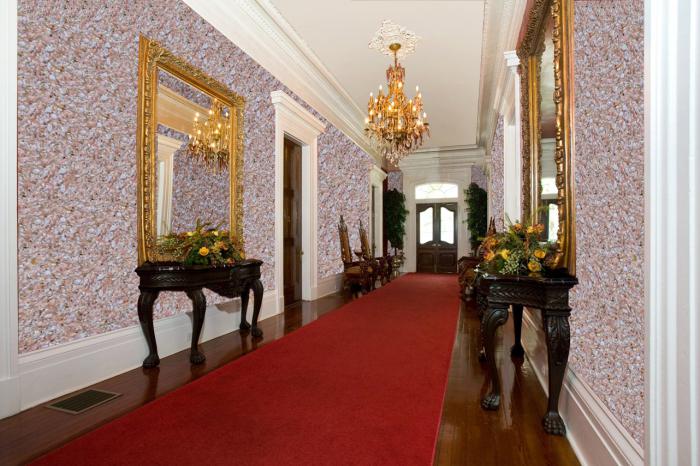
Minor irregularities and wall defects cannot be hidden with wallpaper or water-based paint. Leveling the walls with a cement-sand mixture can lead to the formation of a rather thick layer, at least 3 cm. This is done in order to avoid cracking, but requires additional costs. Liquid silk plaster can hide small flaws on the walls, but this will require a layer of 1-2 mm. Due to the high cost of the material, it is desirable to conduct high-quality wall preparation before finishing.
The advantages of the material should also include the fact that it can be applied to almost any coating: brick, concrete, wood, metal. It does not leave traces of joints, even if the work was carried out in several stages in different areas. Sometimes, for better adhesion of the plaster to the wall, it is recommended to use special primers. In the case when repairs are carried out in a new building and the shrinkage of the walls has not completely passed, this will not affect the coating, since it is quite elastic and can stretch by more than 5 mm.
Another advantage of the material is the possibility of restoring the damaged part of the coating. To do this, it is enough to moisten it with water and remove it with a spatula, and then apply a new portion. In extreme cases, you can take the old composition, having previously soaked and kneaded it. Silk decorative plaster does not require experience and knowledge in application. This makes it even more attractive for use as a finishing material.
disadvantages
A large number of advantages and a small number of disadvantages is what silk plaster is characterized by. Reviews of experts fully confirm the qualities inherent in the material declared by the manufacturer. As already noted, the main drawback is the high cost of the material. Despite the fact that every year its popularity is growing, and the cost is falling, the price is still relatively high. The disadvantages of plaster also include its excessive moisture absorption, but this can be corrected. You can avoid moisture absorption by the walls by covering them with wax or acrylic varnish. They will visually reduce the “silk” look, but the surface can be washed.
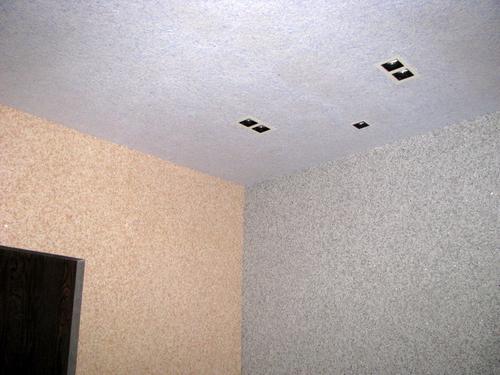
Liquid wallpaper looks great in any room, but there is no need to talk about their wide range of colors in the construction market. Compared to ordinary paper, it seems rather meager. But every year the diversity is growing, and in the near future this shortcoming will be eliminated. Liquid wallpaper does not have sufficient moisture resistance, so they are not intended for washing. If a certain area was dirty or dirty, then it will not work to clean it with a rag soaked in soapy water. In this case, the damaged area must be cut out, and the resulting "gap" should be covered with the remnants of wallpaper diluted in warm water.
It is also important to remember that plaster absorbs all odors, like its counterparts. Therefore, in the kitchen or in the toilet, it is highly recommended not to use such finishing material as silk plaster. The photo of the bathroom at the same time clearly indicates that even in places for which it is not intended, it looks harmonious with other elements of the interior. The disadvantages of plaster include the fact that it darkens over time. Therefore, new material is not always suitable for local repairs, but you will have to reuse the one that was removed from the problem area.
Liquid wallpaper "Silk Plaster"
"Silk Plaster" is a finishing material of domestic production with its own characteristics and characteristics. For its production, natural cellulose, silk fibers, mineral filler, colored quartz and various additives are used. The components are exclusively natural, so the plaster is harmless. Silk Plaster is CE marked. It means that the material meets European standards. Where to buy silk plaster? It can be purchased at almost any hardware store.
Silk-like plaster differs in its structure: with small fibers it is applied to a coating 2-3 mm thick. Other types lie down with a greater thickness, namely 4-5 mm. At the same time, they are more reminiscent of a fabric surface and look more voluminous. 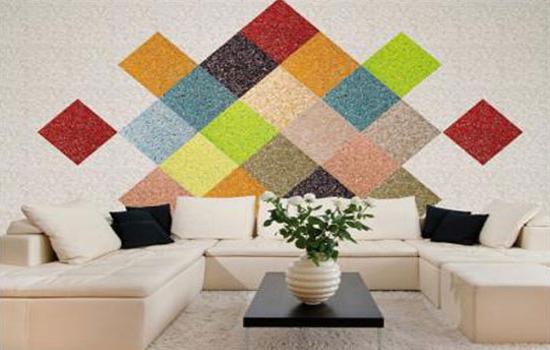
Applying silk plaster in the standard way
Decorative plaster is sold in a package, which is always accompanied by instructions. If you follow it, you can do without the help of specialists. It is enough to take a basin and stir the dry mixture in it with a certain amount of water, which can be specified in the instructions.
Primer
The material is initially quite viscous, but it is desirable to increase its adhesion to the surface. To do this, it is recommended to use a special primer for decorative compositions, for example, acrylic. It is applied with a brush, carefully lubricating the entire surface.
Ceiling preparation
Applying liquid wallpaper to the ceiling is a difficult and time-consuming task. In this case, as with any other foundation, it must be carefully prepared. First of all, the surface is cleaned of wallpaper, paint or whitewash. After that, they begin to putty. This stage is especially important, since its poor-quality execution can lead to material overruns. In other words, silk plaster, the price of which is quite high, will have to be applied in several layers due to poor preparation of the base and the presence of cracks or any other defects on it. And these are additional costs.
First layer
Small portions of plaster are scooped up with a medium-sized plastic trowel and applied to the coating with arbitrary strokes. After that, the mixture is leveled from corner to corner, without lifting the tool from the surface, as this can lead to the formation of seams. You need to put pressure on the tool in moderation, otherwise the material may be compressed. The intervals between strokes should be minimal. The optimum layer thickness is 2 mm. There are two most common material application techniques: droppe and moon. At the first, small strokes are made in different directions, due to which the effect of plexus of leaves is obtained. The second technique differs from the first by radial movements when applying the solution. The thickness of the layer in this case is not more than 1 mm.
Very popular It dries up for 2-3 days. In this case, the room must be ventilated, which will allow moisture to evaporate from the wallpaper. It is also important to ensure that the temperature in the room does not fall below 10 degrees. "Real" color silk plaster "Silk Plaster" will receive after drying.
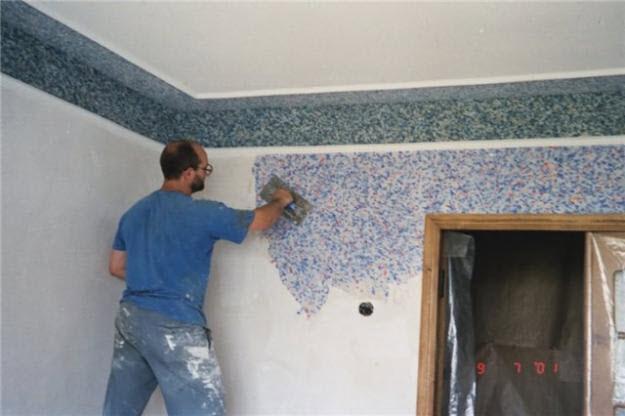
Second layer
To create a "silk" effect, one layer of material is often not enough. Therefore, it is necessary to apply at least one more layer according to the technique used earlier. Droppe often requires a third layer of plaster. He will make it as similar as possible to the imitated material, since because of this, silk plaster is used in the interior. The photo of the walls, on which the material is applied by different techniques, testifies to their striking visual difference.
To imitate velvet, crinkled silk or printed fabric, it is desirable to apply the composition with a textured roller. It is important to ensure that the relief on the nozzles is no more than 3 mm at the highest point, since maintaining the correct layer thickness is an important component of quality work. Rollers make it possible to organize the most complex patterns or folds of fabric on the coating. And all this allows you to do silk plaster. Photos of finished works show the wide possibilities of the material.
The resulting surface is leveled with a special plastic grater. It is important to understand that achieving a perfectly even coating will not work. And there is no need for this, since the liquid wallpaper will level itself during the solidification process.
Application on concrete and brick substrates
The surface is preliminarily puttied with a gypsum mixture, leveling it. After drying, the FG primer is carried out in two or more layers, and painted with white water-dispersion paint. If there is no FG, then it is allowed to paint with a mixture of facade water dispersion with ordinary PVA, mixing them in a ratio of 2: 1. It is important to correctly calculate the thickness of the putty layer, since its insufficient thickness can provoke the appearance of a gray tint from the concrete wall. The paint is applied in three layers: the first layer is protective, and the other two are strengthening. 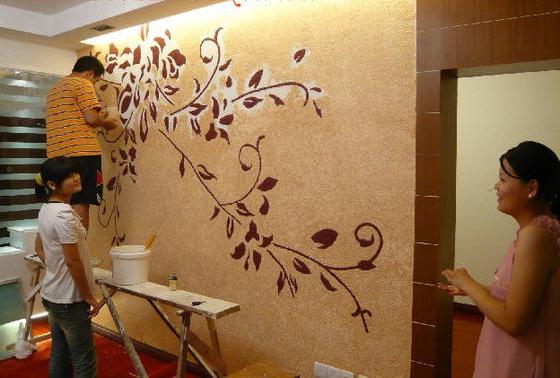
The use of liquid wallpaper in "Khrushchev"
In old buildings, yellow or gray spots often appear on the walls. Therefore, before application, it should be carefully prepared and strengthened. They are applied from two layers of FG and painted over with water dispersion, as for houses with brick or concrete bases. Instead of FG, you can use oil or
For plasterboard walls
Plasterboard walls are carefully covered with putty (over the entire area of the sheets). One of the most common mistakes is that only joints are filled with putty. This is not enough to create the smooth surface that silk plaster requires. Feedback from experienced builders fully confirm this rule. After drying, as in other cases, the wall is painted with water-dispersion paint.
Drywall is a highly absorbent material. In this regard, water-dispersion paint is recommended to be mixed with PVA in a ratio of 3:1. This will strengthen the putty. It is also advisable to use galvanized self-tapping screws, as they will not leave rust marks on the wall surface.
For wood sheets, plywood, fiberboard and MDF
Before applying liquid plaster to these surfaces, make sure that the wood does not shrink and is not exposed to moisture. You can protect the base from deformation using oil paint. For this purpose, a FG solution is also suitable, which should be applied in 2-3 layers. 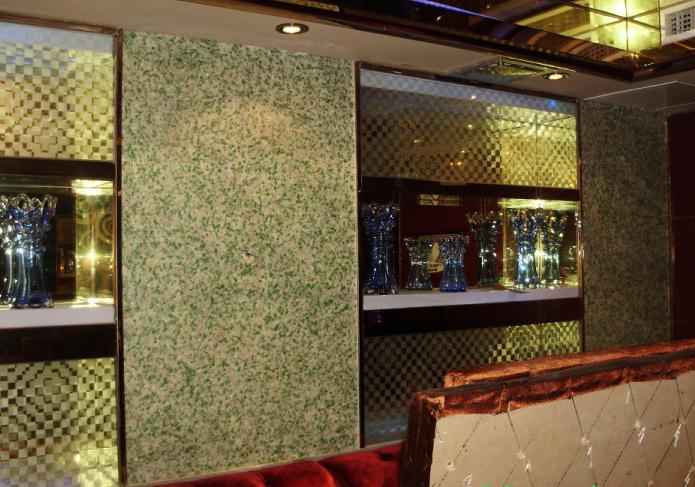
Coating care
All types of decorative plasters are very practical, and their care does not require any skills or knowledge. Most liquid wallpaper is washed with a simple soapy solution, for example, "Venetian". Embossed and textured wallpapers are enough to periodically vacuum. The coating can even last for decades if the composition was chosen correctly, and all the instructions indicated on the package were followed. This is another reason for their popularity.
Price
How much does silk plaster cost? The price of liquid wallpaper largely depends on the manufacturer, which can not always be said about its quality. The French Senideo plaster is known for its high quality, the manufacturing company is the leader in the production of silk plaster. The quality of the products of the Turkish companies Silkcoat and Bayramix koza is practically not inferior to their French competitors, and its price is much lower. "Stenol" and "Danish decorative plaster" - Russian counterparts. Their silk decorative plaster, the price of which is 150-400 rubles, is not much inferior to well-known brands. In this case, one package of the mixture is enough for 5 m 2 of the surface.
Calculating the amount of material for the room is simple, since one kilogram of the mixture covers 5 m 2 of the surface. For example, if the area of the room is 25 m 2, then for its full decoration you will have to buy at least 5 packs of the mixture. And if you don’t know how much silk plaster costs on average, then you can take the price of 300 rubles / kg as a guide.